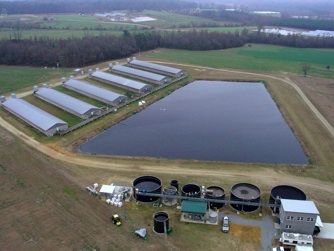
News
New bacteria found in swine manure named after scientist
March 6, 2009 by Jan Suszkiw USDA Agricultural Research Service
 March 6, 2009 – Robinsoniella peoriensis is the name of a new bacterial species discovered in swine manure by Agricultural Research Service (ARS) and cooperating scientists.
March 6, 2009 – Robinsoniella peoriensis is the name of a new bacterial species discovered in swine manure by Agricultural Research Service (ARS) and cooperating scientists.
March 6, 2009 – Robinsoniella peoriensis is the name of a new bacterial species discovered in swine manure by Agricultural Research Service (ARS) and cooperating scientists.
 Scientists with the ARS National Center for Agricultural Utilization Research (NCAUR) in Peoria, Ill., the University of Oklahoma (OU) at Norman, and the University of Göteborg (UG) in Sweden concluded the bacterial species was new after comparing its ribosomal gene, 16S rDNA, to other species and analyzing its cellular fatty acids and other biochemical characteristics.
Scientists with the ARS National Center for Agricultural Utilization Research (NCAUR) in Peoria, Ill., the University of Oklahoma (OU) at Norman, and the University of Göteborg (UG) in Sweden concluded the bacterial species was new after comparing its ribosomal gene, 16S rDNA, to other species and analyzing its cellular fatty acids and other biochemical characteristics.
The team discovered R. peoriensis – named in honor of microbiologist Isadore M. Robinson, formerly with ARS – while cataloging microbial populations that inhabit swine manure and produce its offending odor.
Collecting such information can yield important clues for figuring out new ways of diminishing the odors, according to microbiologist Terence Whitehead, with NCAUR’s Fermentation Biotechnology Research Unit. One approach being studied there involves using condensed tannins or other compounds to inhibit hog pit bacteria. Besides smelling foul, the manure also emits gases like ammonia and methane that can be environmentally harmful.
Whitehead credits Robinson with pioneering studies on anaerobic bacteria that aid digestion in the rumens of cows and sheep. Robinson conducted his studies, beginning in 1957, at the ARS (then-named) Dairy Cattle Research Branch in Beltsville, Md., and, after 1965, at the ARS National Animal Disease Center in Ames, Iowa. He retired there in 1987.
At Peoria, the team isolated five strains of R. peoriensis from samples collected from a nearby hog farm. Coincidentally, the strains’ 16S sequence matched that of an isolate taken from a completely different environment – the heel infection of a 79-year-old Swedish woman, according to a UG analysis.
Whitehead and co-authors Michael Cotta of NCAUR, Paul Lawson of OU, and Enevold Falsen and Edward Moore, both of UG, recently reported on R. peoriensis in the International Journal of Systematic and Evolutionary Microbiology. Their analysis of GenBank sequence data showed the five strains were virtually identical to one another, but different enough from other anaerobes to warrant classification as a new genus.